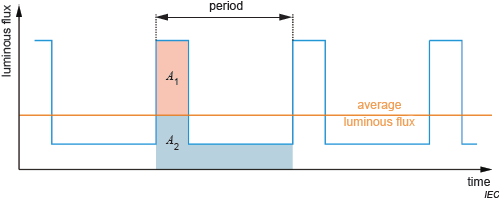| quotient of the above-average luminous energy to the total luminous energy over a period of time Note 1 to entry: The above-average luminous energy is the luminous energy calculated from the amount that the instantaneous luminous flux exceeds the average luminous flux. When the instantaneous luminous flux is less than the average luminous flux, the above-average luminous energy is zero, i.e. it does not add negatively. Note 2 to entry: For the region under the curve of a graph of the instantaneous luminous flux versus time, the flicker index is equivalent to the ratio of the area above the average luminous flux to the total area. This is expressed mathematically as , where A1 is the area above the average luminous flux and A2 is the area below the average luminous flux as indicated in the following figure: X
Note 3 to entry: The flicker index has to be calculated over an integral number of periods over which the signal is repetitive. For sources run at 50 Hz, this is normally 20 ms or 40 ms or 60 ms, etc., while for sources run at 60 Hz, this is normally 16,67 ms or 33,33 ms or 50 ms, etc. Note 4 to entry: Although the flicker index is defined here in terms of the luminous energy of the source, it can also be obtained through measurements of other luminous quantities such as luminous intensity, illuminance and luminance. Note 5 to entry: The flicker index does not take into account the effect of modulation frequency and the effect of multiple frequencies in case of more complex light waveform modulations. See also CIE TN 006:2016, Visual Aspects of Time-Modulated Lighting Systems – Definitions and Measurement Models. Note 6 to entry: The flicker index has unit one.
|